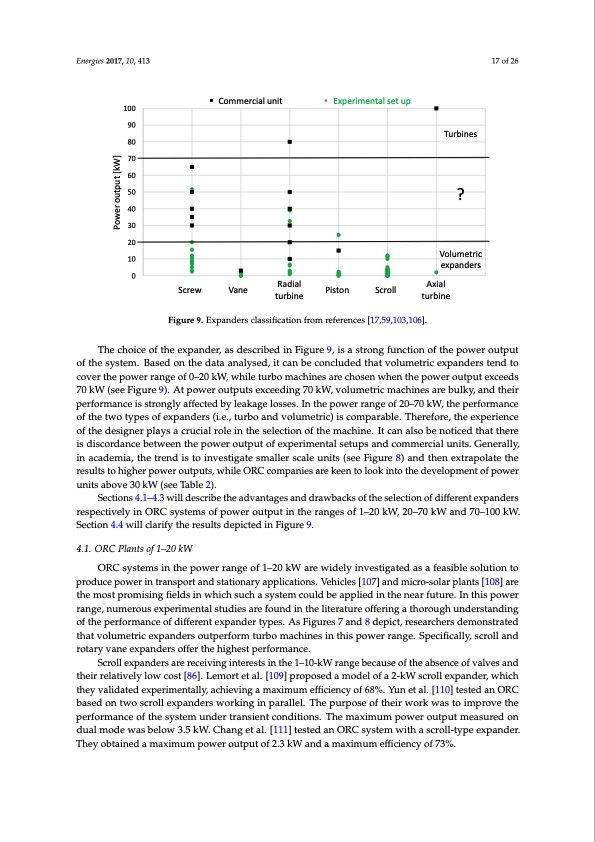
PDF Publication Title:
Text from PDF Page: 017
Energies 2017, 10, 413 17 of 26 100 90 80 70 60 50 40 30 20 10 0 Commercialunit • Experimentalsetup Screw Vane Radial turbine Piston Scroll Axial turbine Turbines ? Volumetric expanders Figure 9. Expanders classification from references [17,59,103,106]. The choice of the expander, as described in Figure 9, is a strong function of the power output of the system. Based on the data analysed, it can be concluded that volumetric expanders tend to cover the power range of 0–20 kW, while turbo machines are chosen when the power output exceeds 70 kW (see Figure 9). At power outputs exceeding 70 kW, volumetric machines are bulky, and their performance is strongly affected by leakage losses. In the power range of 20–70 kW, the performance of the two types of expanders (i.e., turbo and volumetric) is comparable. Therefore, the experience of the designer plays a crucial role in the selection of the machine. It can also be noticed that there is discordance between the power output of experimental setups and commercial units. Generally, in academia, the trend is to investigate smaller scale units (see Figure 8) and then extrapolate the results to higher power outputs, while ORC companies are keen to look into the development of power units above 30 kW (see Table 2). Sections 4.1–4.3 will describe the advantages and drawbacks of the selection of different expanders respectively in ORC systems of power output in the ranges of 1–20 kW, 20–70 kW and 70–100 kW. Section 4.4 will clarify the results depicted in Figure 9. 4.1. ORC Plants of 1–20 kW ORC systems in the power range of 1–20 kW are widely investigated as a feasible solution to produce power in transport and stationary applications. Vehicles [107] and micro-solar plants [108] are the most promising fields in which such a system could be applied in the near future. In this power range, numerous experimental studies are found in the literature offering a thorough understanding of the performance of different expander types. As Figures 7 and 8 depict, researchers demonstrated that volumetric expanders outperform turbo machines in this power range. Specifically, scroll and rotary vane expanders offer the highest performance. Scroll expanders are receiving interests in the 1–10-kW range because of the absence of valves and their relatively low cost [86]. Lemort et al. [109] proposed a model of a 2-kW scroll expander, which they validated experimentally, achieving a maximum efficiency of 68%. Yun et al. [110] tested an ORC based on two scroll expanders working in parallel. The purpose of their work was to improve the performance of the system under transient conditions. The maximum power output measured on dual mode was below 3.5 kW. Chang et al. [111] tested an ORC system with a scroll-type expander. They obtained a maximum power output of 2.3 kW and a maximum efficiency of 73%. Power output [kW]PDF Image | Small Scale Organic Rankine Cycle (ORC)

PDF Search Title:
Small Scale Organic Rankine Cycle (ORC)Original File Name Searched:
energies-10-00413-v2.pdfDIY PDF Search: Google It | Yahoo | Bing
NFT (Non Fungible Token): Buy our tech, design, development or system NFT and become part of our tech NFT network... More Info
IT XR Project Redstone NFT Available for Sale: NFT for high tech turbine design with one part 3D printed counter-rotating energy turbine. Be part of the future with this NFT. Can be bought and sold but only one design NFT exists. Royalties go to the developer (Infinity) to keep enhancing design and applications... More Info
Infinity Turbine IT XR Project Redstone Design: NFT for sale... NFT for high tech turbine design with one part 3D printed counter-rotating energy turbine. Includes all rights to this turbine design, including license for Fluid Handling Block I and II for the turbine assembly and housing. The NFT includes the blueprints (cad/cam), revenue streams, and all future development of the IT XR Project Redstone... More Info
Infinity Turbine ROT Radial Outflow Turbine 24 Design and Worldwide Rights: NFT for sale... NFT for the ROT 24 energy turbine. Be part of the future with this NFT. This design can be bought and sold but only one design NFT exists. You may manufacture the unit, or get the revenues from its sale from Infinity Turbine. Royalties go to the developer (Infinity) to keep enhancing design and applications... More Info
Infinity Supercritical CO2 10 Liter Extractor Design and Worldwide Rights: The Infinity Supercritical 10L CO2 extractor is for botanical oil extraction, which is rich in terpenes and can produce shelf ready full spectrum oil. With over 5 years of development, this industry leader mature extractor machine has been sold since 2015 and is part of many profitable businesses. The process can also be used for electrowinning, e-waste recycling, and lithium battery recycling, gold mining electronic wastes, precious metals. CO2 can also be used in a reverse fuel cell with nafion to make a gas-to-liquids fuel, such as methanol, ethanol and butanol or ethylene. Supercritical CO2 has also been used for treating nafion to make it more effective catalyst. This NFT is for the purchase of worldwide rights which includes the design. More Info
NFT (Non Fungible Token): Buy our tech, design, development or system NFT and become part of our tech NFT network... More Info
Infinity Turbine Products: Special for this month, any plans are $10,000 for complete Cad/Cam blueprints. License is for one build. Try before you buy a production license. May pay by Bitcoin or other Crypto. Products Page... More Info
| CONTACT TEL: 608-238-6001 Email: greg@infinityturbine.com | RSS | AMP |